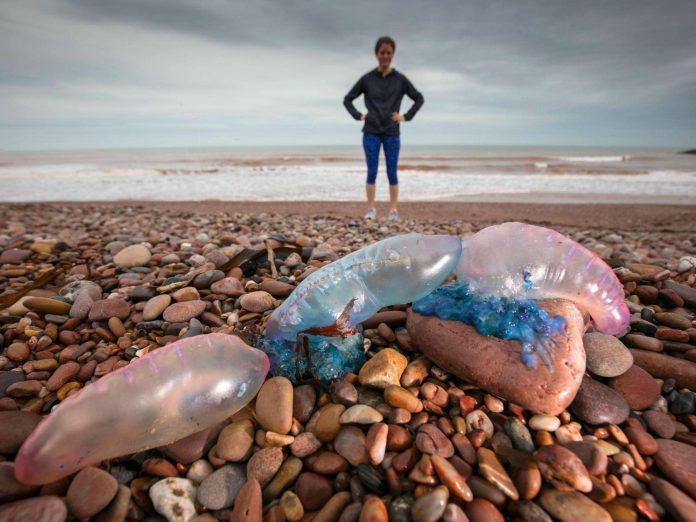Destination values, native heritage, and cultural identity are what Etnia Nativa advocates for as its own particular way of safeguarding all reasons to love Aruba. Through this cultural blog, “Island-Insight,” we share awareness, educate, and safeguard native heritage. It is how we encourage you to experiment with an island-keeper state of mind during your stay.
To “thrive like a local,” you need to be informed, to learn, to stay safe, and to be aware that nature can be unforgiving. Jellyfish, or medusa, as they are known in biology, are occasional ocean visitors that have been spotted on various beaches on our island in recent days. They are fascinating beings that captivate us when in aquariums but make us run from the sea when we are in direct contact with nature!
Although they are not the most primitive animals, it is said that they keep the secret of evolution. There are fossil records from the Primary Era (more than 500 million years ago). They are from the Cnidarian group and appeared before sponges. Most jellyfish live a few miles offshore and only come close to shore with high winds or strong currents. Jellyfish are not “hunters,” but many carry special cells in their tentacles to immobilize their small victims. The same that burn our bodies and make us feel very sick when reacting to the poison carried by different species.
Despite not being a true jellyfish, the Portuguese man-of-war (Physalia physalis) is often classified as a killer jellyfish. It should be noted that there are no killer jellyfish in our direct area; however, we can be very sensitive to their sting, which is very painful and only fatal in cases of allergy or very extreme exposure.
The truth is that each jellyfish is a unique animal, and in the case of the Portuguese man of war, it is a floating colony made up of smaller, genetically identical entities that live and work in unison.
At first glance, the Portuguese man-of-war is very striking and even beautiful to look at, but it is better to keep a safe distance and never, under any circumstances, touch one. It is partially transparent. It lacks a backbone and kills its prey with stinging tentacles. It feeds on small fish and plankton.
The bites cause intense pain to humans, leaving red, whip-shaped welts on the skin that typically last two to three days, although the pain should subside after about 1 to 3 hours (depending on the person’s biology).
However, the venom can travel to the lymph nodes and cause symptoms that mimic an allergic reaction, including swelling of the larynx, blocked airways, cardiac distress, and the inability to breathe. Other symptoms can include fever, shock, and, in some extreme cases, death, although this is extremely rare.
We must be aware that dead specimens, even a detached tentacle (those that wash ashore), can sting as painfully as the living organism in the water and can remain potent for days after the organism has died or the detached tentacle has been in contact with one’s skin.
You should never scratch or rub the affected area with sand. Locals say that you must urinate on the stringed area; it is thought to relieve hives. The “urticaria” is formed by jellyfish cells at the time of contact that adhere to our skin. If those cells die, they stop emitting the toxic element. An acid, such as urine, can neutralize them, although it is not the best solution. In this regard, acetic acid rather than vinegar may be preferable. Also, a change in the salinity of the cells can cause the release of more poison, just as occurs with urine or fresh water. Hence, only salty sea water can provide slight relief. So to stay on the safe side, you better go see a doctor.
Medical attention may be necessary to relieve pain or open the airways if the pain becomes excruciating, lasts more than three hours, or if breathing becomes difficult. Cases in which bites completely encircle a young child’s trunk are among those that have the potential to be fatal. However, Aruba is safe for now, and the main thing is to be aware and prudent.
If you’re intrigued by Aruba`s native lifestyle and its cultural heritage do something outside of the tourist grid. Become one of the exclusive visitors of Etnia Nativa, a private museum/home where you will be able to touch and be touched by authentic Aruba heritage, a spectacle of native art, archaic as well as archaeological artifacts, lithic tools, colonial furniture, and other items of the island’s bygone era.
Etnia Nativa is, since 1994, the home of Anthony, our acclaimed columnist, artist craftsman, and island Piache, who guides and lectures you through his resplendent collection. Etnia Nativa is the only place that recreates and introduces you to an authentic glimpse into native cultural heritage. Something completely different for a change—a contemporary Native Aruba experience!
Appointment is requiredWhatsapp + 297 592 2702 or etnianativa03@gmail.com
















